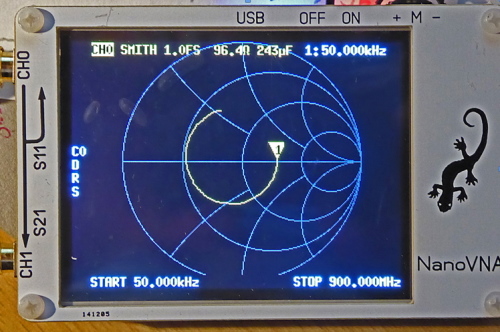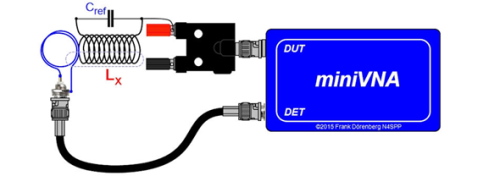Home
November 2019 - An inexpensive Vector Network Analyser (The “NanoVNA”).
I really didn't need one of these devices. I am fortunate to own a DG8SAQ VNWA3 from SDR-Kits.
These are very widely respected professional devices - but I was led into temptation by a good friend who we will call "Ted".
Now Ted had ordered a NanoVNA and asked for some guidance how to install and use it - so I borrowed his and set about teaching myself how to operate it. I became smitten with the litte device and so ordered one of my own.
When I give club talks it is invariably about QRP and test equipment. Not everyone will want to splurge on a VNWA3 - but the NanoVNNA is affordable. Very affordable - and very portable..
This unit is available for between £30 and £50 – depending who you order it from and how long you are prepared to wait for it to arrive. I ordered mine from Amazon with next day delivery. I think I got lucky as there are some awful clones out there. In future I would only order from approved suppliers.
Mine was £39 with free shipping and it came complete with test cables and calibration terminators. It can be powered from an internal lithium battery but it seems to vary whether you get one - but it can also be powered from your PC via a USB lead (also supplied).
Mine did not come with a battery but I ordered one from Amazon for under £3 including delivery. Fitting was easy. Plenty of photos found by google for that.
I understand that this battery issue is due to postal safety regulations (and whether the supplier much cares about them). The lithium battery charges from the PC USB port.
This is a full blown VNA which tests not only attenuation but also phase. It is capable of displaying the results in straight-line graph – or Smith Chart form. Although I’ve yet to learn a great deal about Smith Charts, they apparently do enable you to make antenna adjustments to a very fine degree.
The first experiment I tried was characterising a filter.
Here (above) I show a 40M low pass Filter. As you can see, the attenuation trough the filter is pretty low until you reach just beyond 40 metres then it increases considerably as frequency increases. (as it should).
Then I wondered about antenna traps. There is a brilliant article about them in the November Radcom by Tom Harrison, GM3NHQ..
Hitherto I have always used a very old Heathkit Grid Dip Oscillator to test traps and the following photos show a 40M trap that I made and the frequency of the beat note on my TS2000 that accurately shows where the dip was observed. This was 7.212 MHz.
[Test Trap]
Then I used a simple Jig which was designed by Attolini Lucio IW2FND which simply comprised of six 120 Ohm resistors. (www.iw2fnd.it/sites/default/files/docs/Trappole_01_EN.pdf)
I built the jig using surface mount resistors and connected it to the trap and to the two ports of the NanoVNA. Firstly, the results as shown on the NanoVNA screen which shows that you don’t have to use a computer.
(above, my NanoVNA in a 3D printed case)
The NanoVNA software produces a result as shown below:
You can set the scan frequencies on the computer and also alter the scales. You will also see two “save” buttons which allow you to store test results. You can save both single port tests (like SWR) and two port tests (attenuation etc).
PC Software.
You can send the saved file to a friend if they also have the software - and they can play with the results as if they were being taken live. There are many videos on Youtube. Just search for “NanoVNA”.
By far the greatest asset to the NanoVNA owner is membership of the dedicated forum on GroupsIO.
Everything you need is in the files section. plus:links to the various available software, manuals etc.including this great new document from member L Rothman who has written this 37 page User Manual. Please Note. This is not my document to distribute - so the link is to the files section of the group which you must join to download.
Update December 2019:
I later made a trap for 10 metres and tested it using the IW2FND jig. It didn't come out where the VE6YP design software says it should and I reverted to the tried and trusted Heathkit GDO which did agree with the software. The conclusion had to be that the jig was affecting the test.
A search on the web found some very good advice from Frank N4SPP when using the MiniNVA in the same situation. He suggests just poking one lead of the trap in the "DUT" socket and then plug a probe loop into the detector port.
The coupling to the trap is much lighter, and just like using a GDO, you can vary the coupling by moving the probe coil toward or away from the trap. Here is my probe and it works very well.







